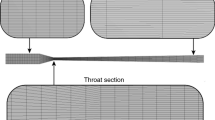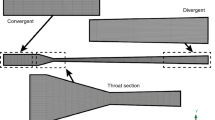Abstract
Dry ice blasting plays an essential role in today’s cleaning industry, where many industry players have used it after realizing its advantages. The disadvantage of dry ice blasting is relatively small kinetic energy and offer less aggressive clean effect, especially for dual-hose nozzle geometry. This project was mainly to study the impact force of nozzle geometry of dry ice blasting concerning pressure and distance variation. The nozzle geometries with optimum size and shape are fabricated based on a recent literature study. The experimental research on the effect of the impact forces on different pressures and distances has been conducted to validate the simulation study. The result shows that the optimum nozzle design gives better performance than a based model. Besides, the optimum distance for dry ice blasting operation is less than 400 mm for the pressure range of 2 bars to 4 bars. This distance gives the maximum value of the impacted force for dry ice blasting operation in the industry.





Similar content being viewed by others
References
V. Máša, P. Kuba, J. Clean. Prod. 111, 76 (2016)
A.K. Witte et al., LWT 75, 735 (2017)
H.J. Cho et al., Nat. Rev. Mater. 2, 1 (2016)
Q. Blochet et al., J. Therm. Spray Technol. 26, 671 (2017)
M. Ansarizadeh et al., Oilfield Rev. 27, 36 (2015)
X. Guo et al., Appl. Energy 183, 1279 (2016)
R. Sherman, Developments in Surface Contamination and Cleaning (Elsevier, Amsterdam, 2016), p. 695
R. Kohli, Developments in Surface Contamination and Cleaning: Applications of Cleaning Techniques (Elsevier, New York, 2019), p. 117
O.P. Morris, Applications of emerging optoelectronic materials: lead sulphide quantum dots and steam cracker tar. Massachusetts Institute of Technology (2019)
C. Josserand, S.T. Thoroddsen, Annu. Rev. Fluid Mech. 48, 365 (2016)
W. Hoffman, L. King, Applications of emerging optoelectronic materials: lead sulphide quantum dots and steam cracker tar. International Journal Advanced Design and Manufacturing Technology (2019) p 101–114
P.A. Harris, N. Faucher, N. George, P.M. Eidam, B.W. King, G.V. White, S.B. Berger, Discovery and lead-optimization of 4, 5-dihydropyrazoles as mono-kinase selective, orally bioavailable and efficacious inhibitors of receptor interacting protein 1 (RIP1) kinase. J. Med. Chem. 62, 5096–5110 (2019)
J. Curlett, H. Wanlin, Google Patents (2019)
J.O. Morales, A.B. Watts, J.T. McConville, Formulating Poorly Water Soluble Drugs (Springer, Berlin, 2016), p. 165
V. Nguyen et al., Wear 348, 126 (2016)
A. Vardelle et al., J. Therm. Spray Technol. 25, 1376 (2016)
A. Shojaeizadeh et al., Measurement 122, 325–338 (2018)
H.L. Williams, UC Berkeley (2017)
R. Kohli, Developments in Surface Contamination and Cleaning: Applications of Cleaning Techniques (Elsevier, New York, 2019), p. 391
M.N.H. Mat et al., CFD Lett. 11, 18 (2019)
V. Ramji, R. Mukesh, I. Hasan, Applied Mechanics and Materials (Trans Tech Publ, Stafa, 2016), p. 617
M.N.H. Mat, N., Asmuin, Int. J. Integr. Eng. 10, 130–135 (2018).
A. Rudek, Development and validation of a numerical model of the CO2 dry-ice blasting process for aircraft engine cleaning applications. Technological University Dublin p 5096–5110 (2018)
N. Yuvaraj, M.P. Kumar, Mater. Manuf. Process 32, 162 (2017)
J.P. de Sousa Ferreira, Integration of design rules and process modelling within SPIF technology-a review on the industrial dissemination of single point incremental forming. International Journal Advance Manufacturing Technol p 4387–4399 (2017)
S. Dong et al., Surf. Coat. Technol. 268, 46 (2015)
K. Penttilä, (2017)
M. Askarishahi et al., Powder Technol. 274, 379 (2015)
A.M. Ganán-Calvo et al., J. Aerosol Sci. 125, 32 (2018)
G. Spur, E. Uhlmann, F. Elbing, Wear 233, 402 (1999)
S. Dong et al., Mater. Res. Innov. 16, 61 (2012)
J.Y. Yong et al., J. Clean. Prod. 111, 1 (2016)
Acknowledgements
The authors would like to acknowledge financial support from the Ministry of Education Malaysia under Fundamental Research Grant Scheme (FRGS) K080 and Universiti Tun Hussein Onn Malaysia under Geran Penyelidikan Pascasiswazah (GPPS) U966. The author from UTM would like to acknowledge the Ministry of Education (MOE) and Research Management Centre-UTM, Universiti Teknologi Malaysia (UTM) for the financial support through the research grant (vote number 17J52).
Funding
This research was funded by the Ministry of Education Malaysia under Fundamental Research Grant Scheme (FRGS) K080 and Universiti Tun Hussein Onn Malaysia under Geran Penyelidikan Pascasiswazah (GPPS) U966. The APC was funded by Geran Penyelidikan Pascasiswazah (GPPS) U966.
Author information
Authors and Affiliations
Contributions
All the authors were jointly involved in the formulation of the problem, experimental setup and writing up the paper. N.A and M.N.H.M formulate the design experiment, M.G. and M.F.M.B analyze the experimental result, N.H.H. contributes to preparing methodology workflow, and lastly, M.N.H.M, M.G. and M.F.M.B wrote and improved the paper.
Corresponding author
Ethics declarations
Conflict of interest
The authors declare no conflict of interest.
Rights and permissions
About this article
Cite this article
Mat, M.N.H., Asmuin, N.Z., Md. Basir, M.F. et al. Effect of impact force for dual-hose dry blasting nozzle geometry for various pressure and distance: an experimental work. Eur. Phys. J. Plus 135, 260 (2020). https://doi.org/10.1140/epjp/s13360-020-00251-9
Received:
Accepted:
Published:
DOI: https://doi.org/10.1140/epjp/s13360-020-00251-9




